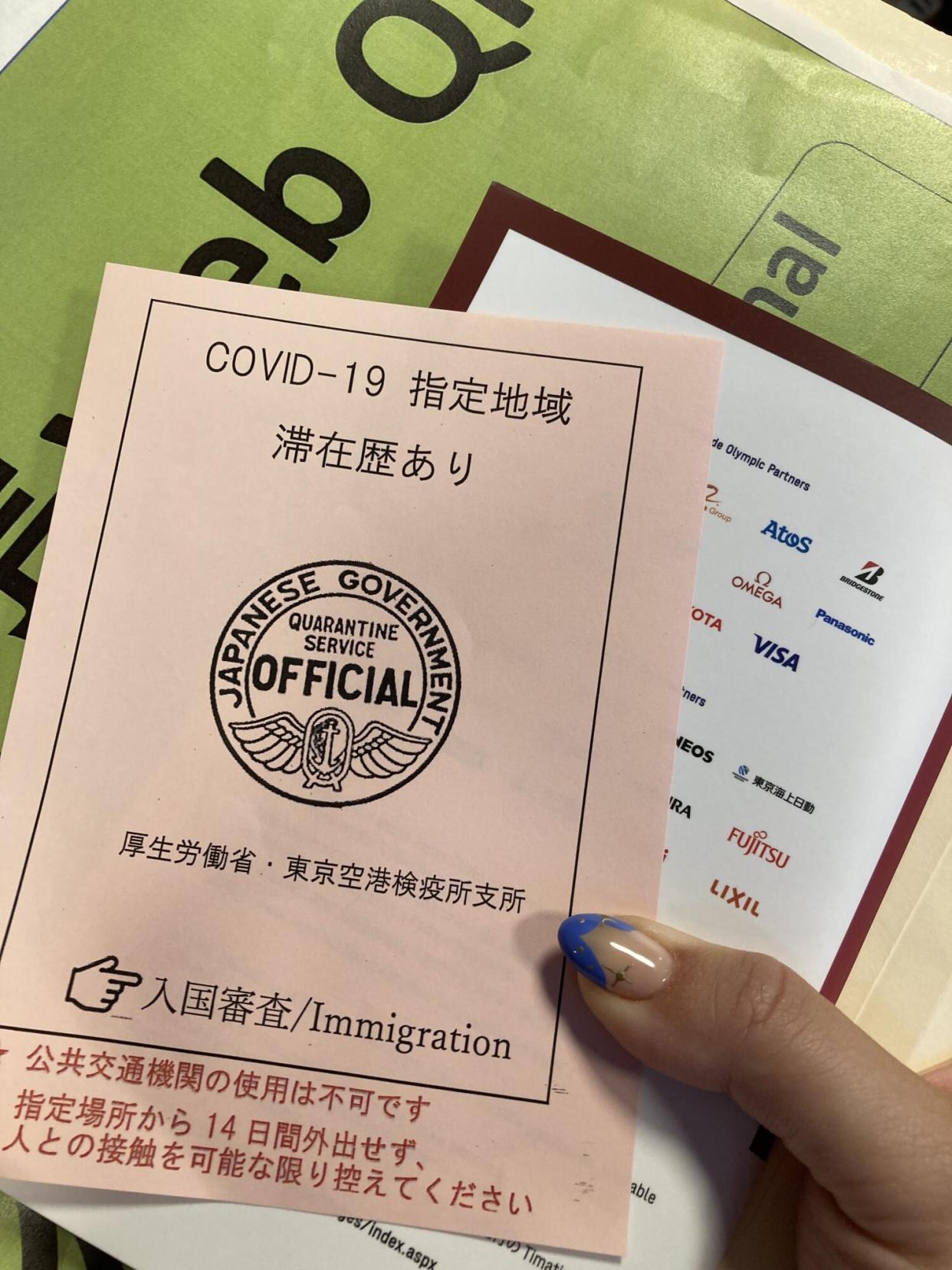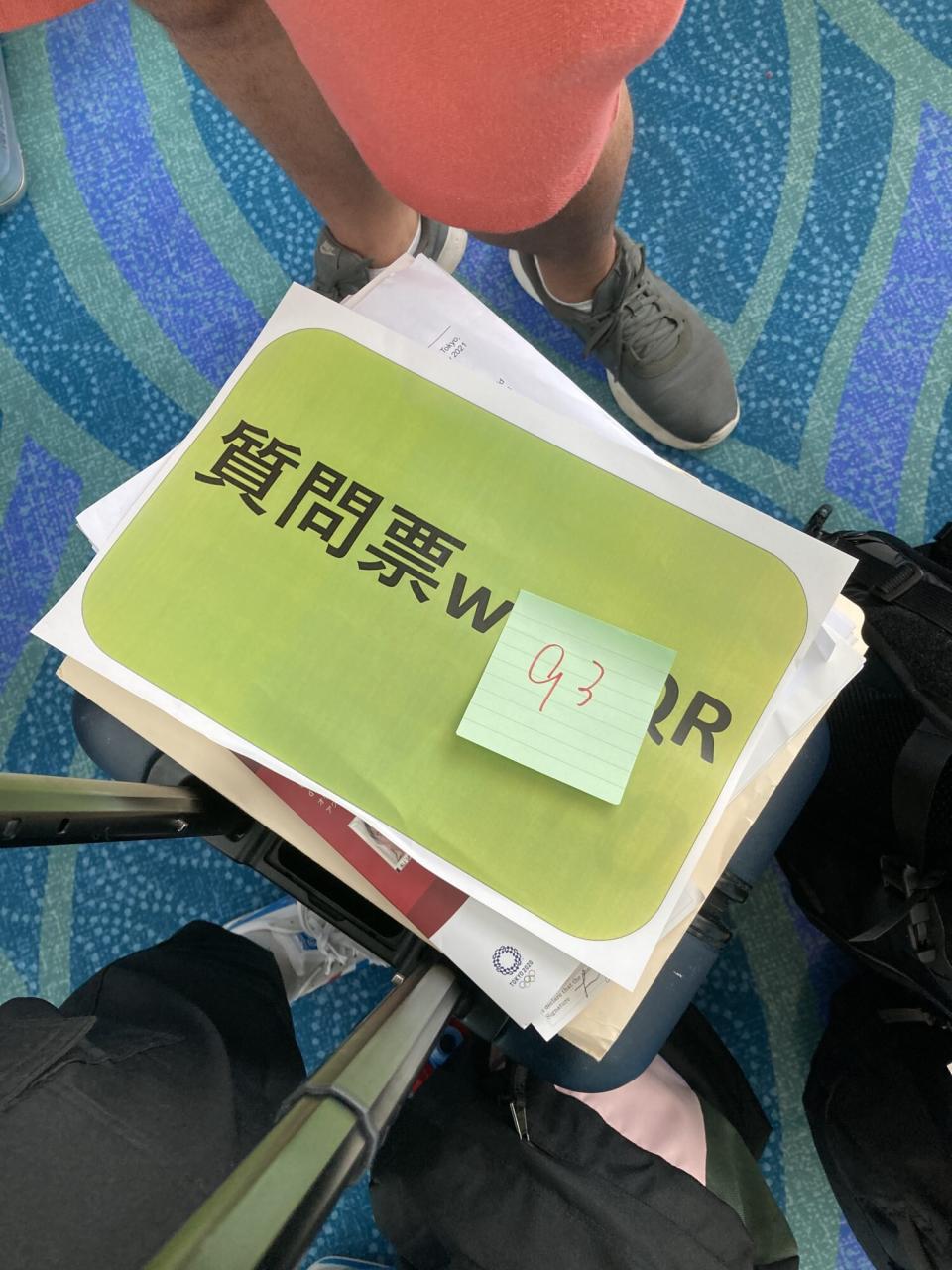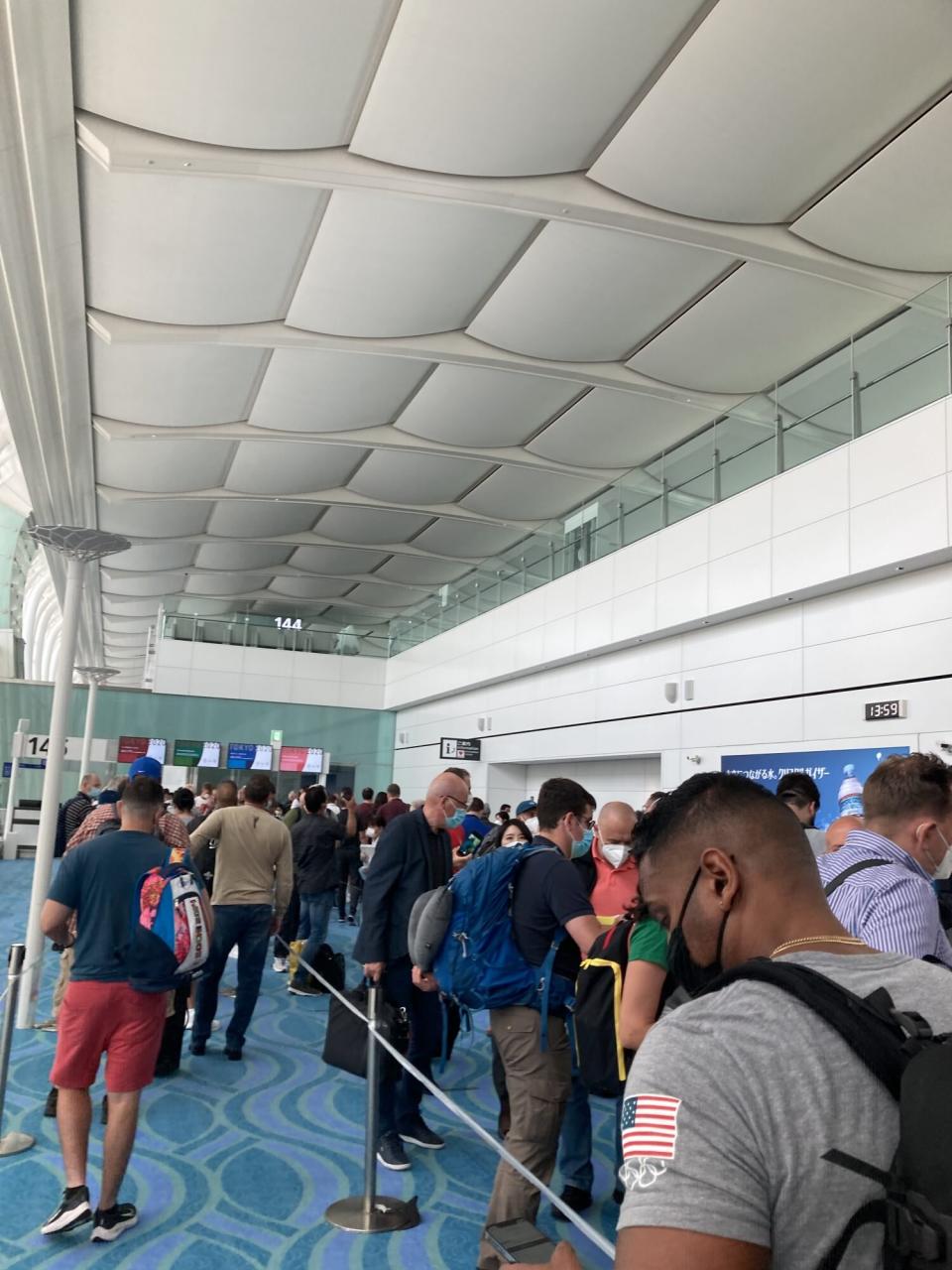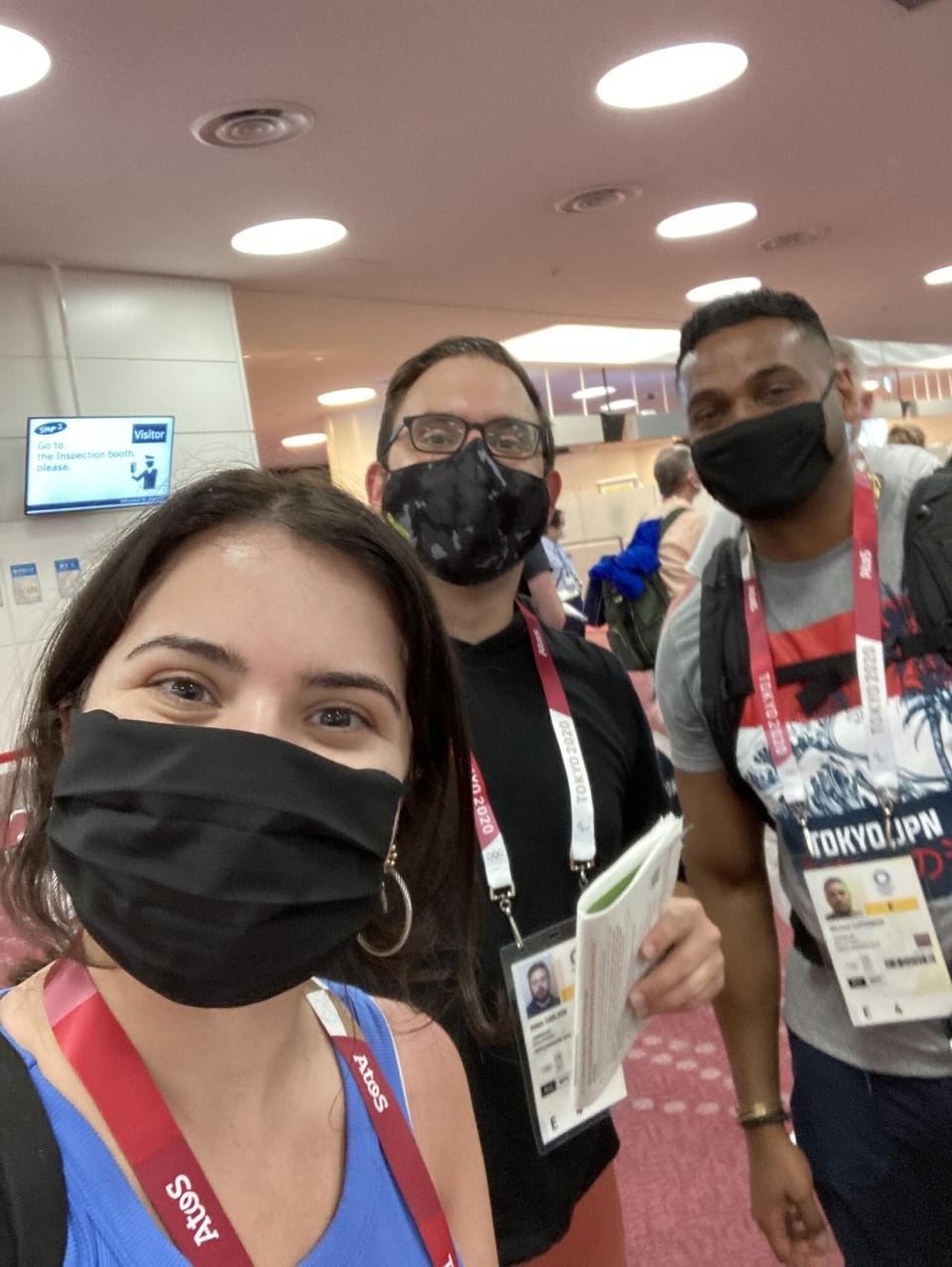Inside the PEOPLE Olympics Reporters' 24-Hour Travel Experience to Cover the Olympics in Tokyo

Lindsay Kimble The COVID-19 results form provided by Tokyo Olympics organizers
After months of rule changes and will-they-or-won't-they, PEOPLE is on the ground in Tokyo for the Summer Olympics — but it wasn't an easy journey.
Four PEOPLE staffers landed in Japan on Tuesday ahead of the Opening Ceremony for the Games, Friday. They'll be among the few allowed in the stands at events and will meet up with athletes after they secure gold to talk all about the unique experience of performing at their best while the world watches.
Lots of preparation and heaps of paperwork set the stage for the quartet's lengthy experience. Three of the Summer Games correspondents share more about the trip, below.
Lindsay Kimble, Senior Digital News and Sports Editor
I live in New York, so I had a multi-part journey to get to Japan that kicked off at 4:30 a.m. EST on Monday when my husband drove me to LaGuardia airport to catch my first flight to Atlanta.
When checking in, I had to show proof that I'd undergone two COVID-19 tests within 96 and 72 hours of my international flight. Only after the Delta desk agent confirmed my negative tests was I given my boarding pass.
RELATED: Every Must-See Photo of Athletes and Stars Arriving at the 2020 Tokyo Olympics
After a short flight to Atlanta, a much longer one began — our 13-hour trek to Tokyo. The plane was almost entirely media, and apparently a few athletes (as the pilot announced over the loudspeaker) and had maybe 60 people on it. It was eerily empty but allowed for me to basically have my own row, a certain upside for a troubled airplane sleeper like myself.
Listen below to our daily podcast PEOPLE Every Day for more on the Olympics.
Once we touched down in Tokyo, those not in the country for the Games were asked to exit the aircraft first. Then, "stakeholders," as we're being called, left the plane and began step one of a nearly 10-step process to being granted admittance to Japan.
We were corralled into a large room with groups of other Games participants (including athletes, all decked out in their country gear), where we had to begin showing different forms and were given even more paperwork. That line led to another room with another line, and then another.

Lindsay Kimble Some of the paperwork required to enter Japan

Lindsay Kimble One of several lines at Tokyo Haneda Airport
Eventually, we were given a plastic cup and funnel to take a coronavirus spit test, which we did in little sectioned-off stalls kind of similar to a voting booth.
Adam Carlson, Politics Editor
Ideally, at some point, teleportation will be invented and no one will need to fly 13 hours from Atlanta to Tokyo or spend any length of time in a pressurized metal tube hurling across the ocean but if you do have to do that, as I did this week, it helps to be seated in one of those otherwise empty rows so that you can lay down and pretend that perhaps you are actually fabulously wealthy and in first class.
(One of our colleagues had actually used a pile of saved-up airline miles to upgrade to one of the lay-flat semi-suites in Delta's business class and before takeoff I joked about sneaking up into one of the empty seats in his section, Bridesmaids-style.)
Anyway.
Things only got noticeably shadowed by the pandemic when we arrived in Tokyo — the snaking lines and procession of checkpoints described above, which all led to a spontaneous moment of panic after I was shepherded into my private booth to fill my vial for my COVID test and I didn't know if I could produce enough spit. How much spit does a mouth produce? It was such a sudden, gross, unusual problem. But I managed it. I won't say more.
Next was the waiting, which is exactly as one can imagine when you have dozens of people — perhaps a hundred or more — gathered in the empty wing of an airport terminal, as socially distanced as possible, waiting for the number of their test results to pop onto a screen that directed them into a line that led to a woman in front of a counter who pointed you to one window, and then the window next to that, where they handed you your results.
And if it was negative, as ours were, then you filed down the stairs and into the final batch of lines and checkpoints.
Most importantly they took booklet-like sheets of paper that were mailed to each of us from the Olympic organizers and tossed most of it away and laminated the single most important sheet from that, the one that included our name and outlet and photo and strings of numbers and symbols, and it became our accreditation for the whole competition.
From there it was a mere stroll (and a few more lines) through immigration and customs.
It turned out that our baggage had arrived from our plane hours ahead of us and a very nice airline worker had been supervising the suitcases where they were set aside next to the carousel.
She knew instantly what we were looking for and, or so I imagined, how long it had taken for us to get to her. She smiled. I smiled back.
RELATED: Olympic Athletes Share Their Pre-Competition Rituals and Superstitions

Lindsay Kimble Three-fourths of the PEOPLE team in Japan
Karen Mizoguchi, Staff Editor
While my three colleagues traveled together from Atlanta to Tokyo Haneda Airport, I was on my own from Los Angeles International Airport (LAX). Ahead of my 10-hour flight, I was at the Japan Airlines check-in counter an hour before it opened because I was filled with worry and concerns about if I had all the correct paperwork and travel documents, which increased tenfold due to the global COVID pandemic. As a form of overpreparation, I had even calculated enough driving time in the case that I had forgotten any documentation and needed to Uber back to my house.
Luckily, everything worked out. My two negative COVID tests (one within 96 hours and the other within 72 hours) were signed off, my accreditation was verified and my boarding pass was issued. What I hadn't planned on was calming my nerves with a Starbucks coffee and a total of three hours of waiting around at the gate.
My flight, which was my first since the pandemic, was also eerily empty and I can now say that I've had an entire row (all 10 seats from A-J) to myself. Another first was wearing a face mask for the entire duration, which felt uncomfortable at times but very necessary. After being instructed to wait until all other passengers left, a small group of Olympic-related "stakeholders" was led off the plane and, like children on a school field trip, were taken to a room for the first of many sign-offs.
Unlike my three other colleagues, the processing of my paperwork and getting my negative COVID result via saliva test was a total of two hours. Next was getting my accreditation laminated and receiving an official Tokyo 2020 lanyard, which made immigration and customs a lot easier.
Finally being able to retrieve my luggage, which was one of four bags left at the baggage claim, was like crossing the finish line at a marathon. The last part of my long day was a 22-minute bus ride to an empty parking lot near the Olympic venues where I jumped into a taxi, which took me to our hotel.
In the end, the time I spent traveling and worrying was far greater than the amount of my first REM sleep in Tokyo.
Stay tuned as we begin to venture outside of quarantine and start attending the events.
To learn more about Team USA, visit TeamUSA.org. Watch the Tokyo Olympics beginning July 23rd and the Tokyo Paralympics beginning August 24th on NBC.

